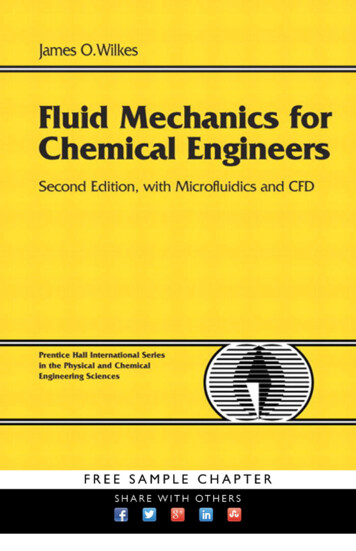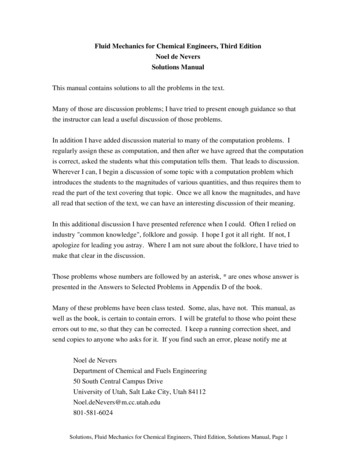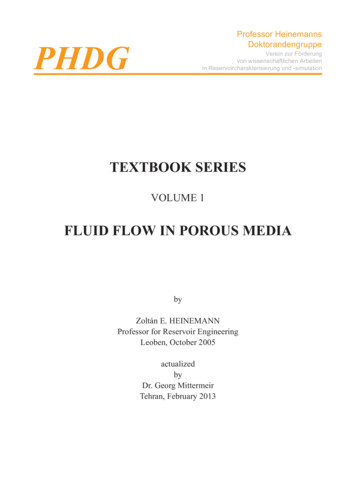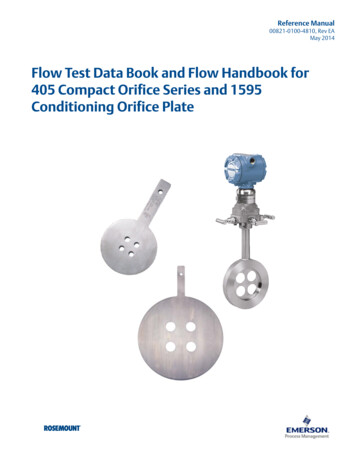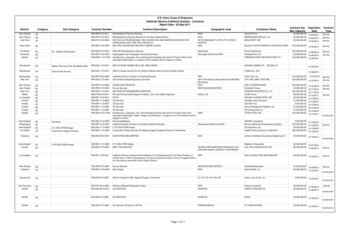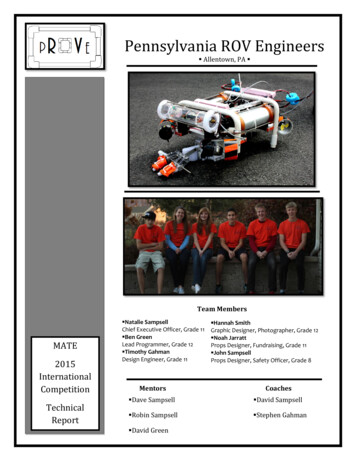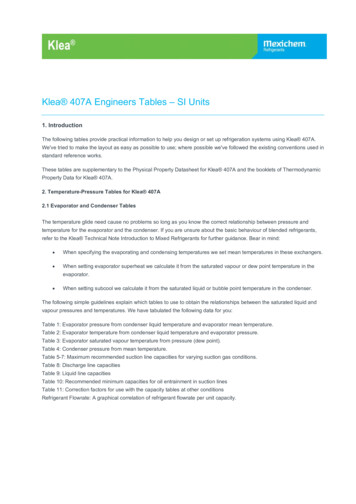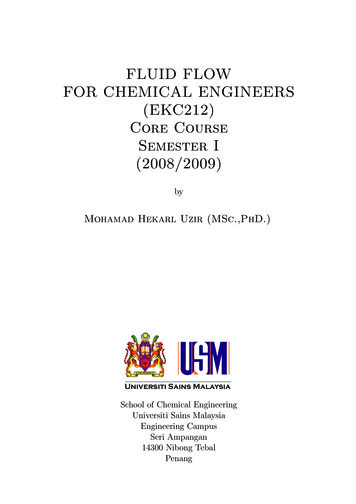
Transcription
FLUID FLOWFOR CHEMICAL ENGINEERS(EKC212)Core CourseSemester I(2008/2009)byMohamad Hekarl Uzir (MSc.,PhD.)School of Chemical EngineeringUniversiti Sains MalaysiaEngineering CampusSeri Ampangan14300 Nibong TebalPenang
Course Contents1. Principles and Basic Definitions of Fluids: Density Viscosity Pressure Unit dimensions and different types of units Units conversion Physical characteristics of fluids2. Fluid Statics and Its Applications: Basic equations Hydrostatic equilibrium in centrifugal field Pressure force Manometer3. Flow of Compressible Fluids: Continuity equation Total-energy balance Mechanical-energy balance Velocity of sound Ideal gas equations Acoustical velocity and NM a (M a) of an ideal gas The asterisk and stagnation conditions Isothermal flow4. Flow Past Immersed Bodies: Drag Drag force Drag coefficients Reynolds number, Re Friction in flow through beds of solids Motion of particles through fluids Stokes’ Law5. Transportation and Metering of Fluids: Pipe, fittings and valves Fluid-moving machinery Orifice meters2
Venturi meters Pitot tube Manometer Rotameter6. Agitation and Mixing of Liquids: Purposes of agitation Impellers Power consumption in agitated vessels Swirling and its prevention Stratified mixing Suspension of solid particles3
1Principles and Basic Definitions of Fluids1. Behaviour of fluids is essential to process engineering.2. It consists of one of the foundations in unit operations.3. Understanding of fluids is important in treating problems on the movement of fluidsthrough pipes pumps all kinds of process equipment4. Fluids include liquids gases vapour5. The area of study of the above fluids is known as fluid mechanics.6. It is in turn a part of a larger discipline called continuum mechanics7. This has 2 main branches: fluid statics: treats fluids in the equilibrium state of no shear stress fluid dynamics: treats fluids when portions of the fluid are in motion relativeto other parts.1.1Density Density is defined as the mass per unit volume of a particular fluid given by;massvolumem VDensity, ρ The higher an object’s density, the higher its mass per unit volume The SI unit of density is the kilogram per cubic metre (kg · m 3 ) Density is also measured in other units, such as;– grams per cubic centimetre (g · cm 3 )– megagrams per cubic metre (Mg · m 3 )– kilograms per litre (kg · l 1 )– pounds per cubic foot (lb · ft 3 )– pounds per cubic yard (lb · yd 3 )– pounds per cubic inch (lb · in 3 )– ounces per cubic inch (oz · in 3 )4(1)
– pounds per gallon (for U.S. or imperial gallons) (lb · gal 1 ) The maximum density of pure water at a pressure of one standard atmosphere is999.861 kg · m 3 ; this occurs at a temperature of about 3.98 C (277.13 K).1.2Viscosity Viscosity is a measure of a fluid’s resistance to flow. It describes the internal friction of a moving fluid. A fluid with large viscosity resists motion because its molecular makeup gives it alot of internal friction. A fluid with low viscosity flows easily because its molecular makeup results in verylittle friction when it is in motion. Gases also have viscosity, although it is a little harder to notice it in ordinarycircumstances. We define the viscosity of the fluid, denoted by η, as the ratio of the shear stress,F/A to the strain rate:Shear stressStrain rateF/A v/lViscosity, η (2) Rearranging equation (2), we see that the force required for the motion of fluid isdirectly proportional to the speed:F ηAvl(3) Viscosities of all fluids are strongly temperature dependent, increasing for gases anddecreasing for liquids as the temperature increases. The unit of viscosity is that of force times distance, divided by area times speed.The SI unit is;1 N · m/[m2 · (m/s)] 1 N · s/m2 1 Pa · s The corresponding cgs unit, is the only viscosity unit in common use; it is called apoise, in honor of the French scientist Jean Louis Marie Poiseuille;1 poise 1 dyn · s/cm2 10 1 N · s/m2 The centipoise and the micropoise are also used. The viscosity of water is 1.79 centipoise at 0 C and 0.28 centipoise at 100 C. For a Newtonian fluid the viscosity is independent of the speed v, and from equation(3) the force F is directly proportional to the speed.5
Rrν versus rFigure 1: Velocity profile for a viscous fluid in a cylindrical pipe. Fluids that are suspensions or dispersions are often non-Newtonian in their viscousbehavior. Figure 1 shows the flow speed profile for laminar flow of a viscous fluid in a longcylindrical pipe. The speed is greatest along the axis and zero at the pipe walls. The motion is like a lot of concentric tubes sliding relative to one another, with thecentral tube moving fastest and the outermost tube at rest. By applying equation (2) to a cylindrical fluid element, we could derive an equationdescribing the speed profile. The flow speed v at a distance r from the axis of a pipe with radius R is;v 1.3p1 p2 2(R r2 )4ηL(4)Pressure Basic property of fluid (static). It is defined as a surface of force exerted by a fluid against the walls of its container.This can be denoted as;forcesurface areaF Ap (5) Pressure exists at every point within a fluid’s volume. For a static fluid, pressure is independent of the orientation of any internal surfaceon which the pressure is assumed to act. Units of pressure is Pascal, (Pa). Other units include;– Newton per metre squared, (N/m2 )– atmosphere, (atm)– bars6
– dynes per centimetre squared (dynes/cm2 )– mm mercury, (mm Hg)– pound force per square inch, (lbf /in2 ), (psi)– feet water, (ft H2 O)1.4Unit Systems The official international system of units is the SI. Many physiochemical data are in cgs units and most calculations are in fgs units. Physical quantities:– they mostly consist of 2 main parts; a unit and a number.– a unit shows the quantity and gives a standard by which it is measured.– a number shows how many units are needed to make up the quantity.– no physical quantity is defined until both the number and the unit are given. SI Units:– it covers the entire field of science and engineering– units are derivable from;1. four proportionalities of chemistry and physics (chemistry, mechanics, gravity and thermodynamics).2. arbitrary standards for mass, length, time, temperature and mole.3. arbitrary choices for the numerical values of 2 proportionality constants. Basic Equations:– Newton’s second law of motion is given by the the proportionality of force andmomentum;dF k1 (mu)(6)dt– Newton’s law of gravitation is given by the proportionality of force and theattraction of 2 particles of masses ma and mb a distance r apart;F k2ma mbr2(7)– The first law of thermodynamics if defined as the proportionality between thework performed by a closed system during a cycle and the heat absorbed bythat system during the same cycle.Qc k 3 Wc(8)– The proportionality between thermodynamic absolute temperature and thezero-pressure limit of the pressure-volume product of a definite mass of anygas.pV(9)T k4 limp 0 m7
– equations (6) to (9) state that if there is a method available in order to measurethe values of all variables and the numerical values of k is calculated, thus, thevalues of k is constant and it depends only on the units used for measuring thevariables in the equation. Standard units;– standards are fixed arbitrarily for the quantities;1. mass: the standard of mass is kilogram (kg)and it is defined as the massof the international kilogram, a platinum cylinder preserved at Sèrves,France.2. length: the standard length is metre, (m) and it is defined as the length ifthe path travelled by light in vacuum during a time interval of 1/299,792,458of a second.3. time: the standard time is second, (s) and it is defined as 9,192,631.770frequency cycles of a certain quantum transition in an atom of 133 Ce4. temperature: the standard temperature is Kelvin, (K) and it is definedby assigning the value 273.16K to the temperature of pure water at itstriple point, the unique temperature at which liquid water, ice and steamexist at equilibrium.5. mole: written as (mol), is defined as the amount of substance comprisingas many elementary units as there are atoms in 12g of 12 C. Method of Determining Constants– using equations (6) and (7), m, ma and mb are in kilograms. Radius, r in metreand u in m · s 1 .– the constants k1 and k2 are not independent but related by eliminating F fromthe above equations:d(mu)k1dt ma mb(10)k2r2– either constants can be fixed arbitrarily, then the other one is found experimentally.– in SI system, k1 is fixed at unity and k2 is found experimentally, (6) thenbecomes;dF (mu)(11)dt– F is the force in newton, (N) used in both equations (6) and (7).– constant k2 is given by G, known as the gravitational constant with value of6.6726 10 11 N·m2 ·kg 2 .– work and energy are measured in newton-metres, (N·m) which is also; 1 J 1 N·m 1 kg·m2 ·s 2 .– power is measured in joules per second, (J·s 1 ) or watt, (W).– heat as can be seen from equation (8) is directly equal to work done;Qc Wcwhere k3 is fixed at unity with the units of joules.8
– for temperature, the quantity, pVcould be measured in joules per unit kilomgram. For a chosen type of gas, such quantity can be determined by measuringthe pressure, p, volume, V and mass, m in a thermostat. Values of pVat varmious p and at constant temperature can¡ be extrapolated. For water at triplepoint, the limiting values is denoted as pVwhich gives;m 0µ ¶pV273.16 k4 lim(12)p 0m 0¡ for an experiment at temperature T, i.e. pV, the Kelvin temperature ism Tdefined as;¡ limp 0 pVm T¡ pV T 273.16(13)limp 0 m 0 CGS Units:– standard for mass is gram, (g)– standard for length is centimetre, (cm)– standard for time, temperature and mole are the same.– the units of force in CGS system is called dyne, (dyn). this is defined as 1 dyn 1 g·cm·s 2 .– the units for energy and work is erg where 1 erg 1 dyn·cm 1 10 7 J.– gas constant denoted as R is given by;µ ¶pVlim Rp 0nT(14)– the constant R is given as 8.31447 J·K 1 ·mol 8.31447 107 erg·K 1 ·mol FPS Engineering Units:– the conversion of the non-SI system is given as follows: 1 lb 0.45359237 kg 1 ft 2.54 12 10 2 m 0.3048 m the thermodynamic temperature is given in Rankine;1K1.8 relationship between Celsius and Fahrenheit scales is given by;1 R T F 32 1.8 C– Pound force, (lbf ) it is defined as a standard gravitational field of force of one pound on amass of one pound. the standard acceleration of free fall in fps units is to five significant figures;9.806650.3048 32.174 ft · s 1 1 lbfgn 9(15)
1.5Units Conversion The 3 different unit systems are commonly used and they are related by the conversion factors. Only defined conversion factors for the base units are required since conversionfactors for other units can be determined from them. Example: Calculate the conversion factors for;1. N to lbf2. BTU to calIT3. atm to lbf ·in 24. hp to kWAnswer:1. Given that;1 N 1 kg · m · s 2and1 lb 0.45359237 kgalso1 ft 2.45 20 2 m 0.3048 mkg · m1 lb1 ft1 2 ··s0.4535 kg 0.3048 msince1 lb · ft · s 2 (16)0.3048lbf9.80665thus multiplied by equation (16)1kg · m1 lb1 ft0.3048···lbf 0.224809 lbfs20.4535 kg 0.3048 m 9.80665(17)Therefore, 1 N 0.224809 lbf2. Given that;1 BTU · lb 1 · F 1 1 calIT · g 1 · C 1thus,1 BTU 1 calITlb · F 0.4535 kg 1000 g 1 C··· 252 calITg · C1 lb1 kg 1.8 F3. Given that1 atm 1.01325 105 kg · m · s 2 · m 2convert the units on the RHS;10(18)
1.6Dimensional Analysis Technique used to solve problems that cannot be tackled theoretically or by anymathematical means. Empirical method should be applied. One example is on correlating pressure loss from friction in a long cylindrical straightpipe. Variables which involve in measurement include;– length of the pipe– diameter of the pipe– flow rate of the liquid within the pipe– density of the liquid– viscosity of the liquid Any small change of the above variables will result in the change of the pressuredrop in the pipe. The empirical method of correlating these variables to the pressure drop is by varyingeach variable separately while keeping the others constant. If a theoretical equation of a certain engineering/scientific phenomenon does notexist, there must be an equation which can relate all these variable and finally giveone dimensionally homogeneous correlation. This method is known as dimensional analysis.– algebraic treatment of symbols which represent the units– no fitting of experimental data required– can be used to check consistency of units in equations as well as during unitsconversion and scale-up of data– this technique still cannot be applied if one does not have a complete information regarding the physics of the situation– such a problem can be easily resolved by referring to the basic differentialequation of fluid flow which incorporate heat of conduction and diffusion– a clean numerical equation is impossible in dimensional analysis and one shoulddevise certain experimental work in order to complete the solution of the problem There are 3 main rules in testing the dimensional consistency of an equation:1. sums of the exponents relating to any given dimension must be the same onboth sides of the equation2. an exponent must itself be dimensionless3. all factors in an equation must be collectible into a set of dimensionless groupsand these groups may carry exponents of any magnitude (they might not bewhole numbers)11
Example: Check whether there is a consistency in any of these empirical equations;1. 0.2 0.47hi 0.023G0.8 k 0.67 c0.33µp D2.hj Da 4.9kµDa V̄ ρµ¶0.57 ³cp µ 0.47k3.Dv 7.4 10 8µDa nV̄¶0.17 µDaL¶0.37(ψB MB )0.5 TµVA0.6 Answers:1. Let the dimensions of the quantities involved in 0.2 0.47µhi 0.023G0.8 k 0.67 c0.33p Dare represented as follows:[hi ] Ht 1 L 2 T 1[D] L Mt 1 L 2[G][k] Ht 1 L 1 T 1[cp ] H
FLUID FLOW FOR CHEMICAL ENGINEERS (EKC212) Core Course Semester I (2008/2009) by Mohamad Hekarl Uzir (MSc.,PhD.) School of Chemical Engineering Universiti Sains Malaysia Engineering Campus Seri Ampangan 14300 Nibong Tebal Penang. Course Contents 1. Principles and Basic Deflnitions of Fluids: † Density † Viscosity † Pressure † Unit dimensions and difierent types of
